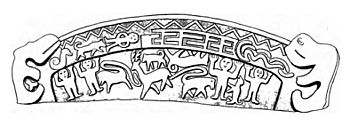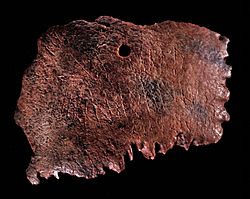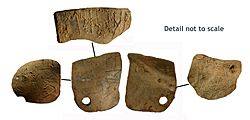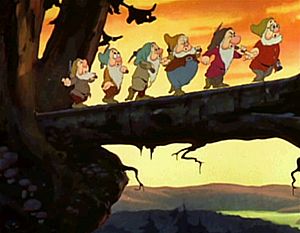Dwarf (folklore) facts for kids
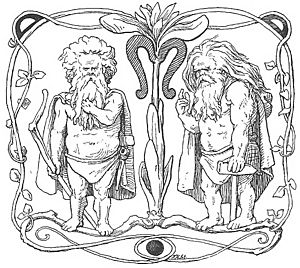
A dwarf is a type of magical being found in old Germanic folklore. Stories about dwarfs have changed a lot over time. But usually, they live in mountains or stones and are very good at making things. In older stories, only male dwarfs are clearly mentioned, even though they have sisters and daughters. Later stories and folklore include both male and female dwarfs. Sometimes dwarfs are described as short, but experts say their height wasn't important in the very first stories.
Dwarfs are still popular today in books and movies, like those by J. R. R. Tolkien and Terry Pratchett. They are often shown as different from elves.
Contents
What's in a Name?
The English word dwarf comes from an old English word, dweorg. Similar words are found in other Germanic languages, like dvergr in Old Norse. Experts believe these words came from an even older word, dwergaz.
Some people think the word dwarf might be linked to the English word dizzy. This could mean dwarfs were once thought to cause mental illnesses in people, much like some other magical beings in old Germanic stories, such as elves.
It's tricky to know the very first meaning of the word dwarf. Some ideas suggest dwarfs might have started as nature spirits, or as beings connected to death. Others think the word might come from old words meaning "damage" or "deception."
Today, the word dwarf has two plural forms: dwarfs and dwarves. Dwarfs is the most common. The word dwarves became popular because of the author J. R. R. Tolkien. He used it in his famous books like The Hobbit and The Lord of the Rings. Tolkien himself admitted it was "a piece of private bad grammar," but he stuck with it!
Old Stories and Legends
Eddic Sources (Old Norse Stories)
Dwarf Names and Types
Experts have noticed that the Svartálfar (meaning 'black elves') seem to be the same as dwarfs. This is because both are said to live in a place called Svartálfaheimr in the Prose Edda (an old Norse book). Another similar group is the dökkálfar ('dark elves'). It's not clear if svartálfar and dökkálfar were always seen as the same.
Some dwarf names in the Völuspá (an old poem) also link them to elves. For example, names like Álfr ('Elf') and Gandálfr ('Wand-elf') appear.
Famous Eddic Dwarfs
Here are some well-known dwarfs from old Norse stories:
- Andvari: This dwarf could change his shape. He was forced by the god Loki to give up his treasure.
- Fjalar and Galar: These two brothers killed a wise being named Kvasir. They then made the mead of poetry from his blood, which gave people the gift of poetry.
- Brokkr and Sindri: These brothers made amazing things for the gods, like Draupnir (a magic ring), Gullinbursti (a golden boar), and Mjölnir (Thor's hammer).
- Sons of Ívaldi: These brothers crafted Gungnir (Odin's spear), Skíðblaðnir (a magic ship), and the golden hair for the goddess Sif.
- Alvíss: This dwarf wanted to marry Thor's daughter. Thor tricked him by keeping him talking until the sun came up, which turned Alvíss to stone.
- Litr: Thor kicked this dwarf into a funeral fire for a reason that isn't clear.
Germanic Heroic Legends and Sagas
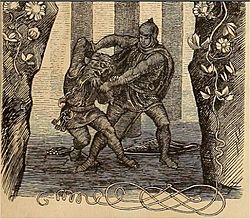
Changes Over Time
After people in Germanic lands became Christian, dwarfs still appeared in their stories. Some experts believe that the old beliefs about dwarfs stayed mostly the same. Others think that dwarfs in later stories were very different from those in the oldest tales.
Old Norse Sagas
Dwarfs appear in many old Norse sagas (long stories). In the Völsunga saga, the dwarf Andvari's treasure causes many events. In another saga, Hervarar saga ok Heiðreks, a dwarf named Dvalinn forges a cursed sword called Tyrfing.
Middle High German Stories
In German literature, many dwarfs can become invisible, often using a "Tarnkappe" (a magic cloak). They can be either helpful or harmful to humans.
The dwarf Alberich is very important in the Nibelungenlied, a famous German poem. He guards a great treasure and is super strong. He is defeated by the hero Siegfried and then serves him. In other stories, Alberich even helps heroes on their adventures.
The hero Dietrich von Bern also has adventures with dwarfs. In the story Laurin, he fights against the dwarf King Laurin in his magic rose garden. Dietrich later saves a woman Laurin had kidnapped. Dwarfs also help Dietrich in other tales, sometimes giving him magic items or helping him escape danger.
Modern Times
Dwarfs are still part of modern folklore in Germanic-speaking areas. For example, the Simonside Dwarfs in England are said to use lights to trick people off paths, like a will-o'-the-wisp (a ghostly light).
Some modern dwarfs are seen as skilled smiths (metalworkers) who live inside hollow mountains or caves. People in Denmark even call certain hills "smith's hill" because they believe dwarfs work there. In some places, the heat from these underground forges is thought to make the soil fertile.
What Are Dwarfs Like?
Different and Mysterious
There isn't just one type of dwarf. They can be very different depending on the region, time, and even among themselves in the same story. Some can even change their shape! One expert, Ármann Jakobsson, says that dwarfs in old stories are hard to define. This might be because they are meant to be hidden and different from humans.
How They Look
Shape and Color
Some people think the very first idea of a dwarf was as a spirit without a clear shape. But the oldest written stories show dwarfs with human-like forms. For example, in the Prose Edda, dwarfs appear with "human form." In other stories, dwarfs are described sitting, standing, and speaking, which suggests they looked like people.
Many dwarf names in old stories are about light and brightness, like Dellingr ('the gleaming one'). This might refer to the fires in their forges. However, some dwarfs, like the dökkálfar (dark elves), are described as "blacker than pitch."
In German heroic poems, most dwarfs have long beards. But some might look like children.
Size
In the very first Old Norse stories, dwarfs are usually described vaguely. They are not always said to be small. However, in later legends and folklore, they are often described as being short.
There are four dwarfs named Norðri, Suðri, Austri and Vestri who, according to the Prose Edda, hold up the four corners of the sky. This might suggest they were very tall! But it could also mean the sky was thought to be close to the ground at the horizon. Some dwarf names, like Fullangr ('tall enough'), are unclear about their size. Other names, like Nori and Nabbi, might mean "tiny" or "little nub," suggesting a small size.
Not all later sagas mention the size of dwarfs, but those that do describe them as short. In some German stories, dwarfs might act like knights but are clearly different from humans because of their small size, sometimes only reaching up to a person's knees. Even though they are small, dwarfs in these stories often have superhuman strength, either naturally or through magic.
Shape Changing
Dwarfs can change their shape and size. For example, in the story Reginsmál, the dwarf Andvari lived as a pike (a fish) in the water, but he could also take on a human shape. In later German folklore, a "Dwarf King" can be tiny but can become very tall whenever he wants.
Gender and Families
In the oldest stories, dwarfs are almost always male. For example, a list of dwarf names only includes males. Some experts thought female dwarfs didn't exist in these early beliefs. However, they are likely mentioned in old charms and are clearly described in later sagas. Dwarfs are also often shown as having families, like brothers and sons. Groups of brothers appear often in old stories.
An old skull fragment from the 8th century has writing that some experts think mentions a dvergynja ('female-dwarf') who might have been causing harm. This is similar to an old English charm that calls on a harmful dwarf's sister to stop him from causing illness.
In some stories, certain Norns (beings who control fate) are called "Dvalinn's daughters," and are described as being "of the dwarfs' kin." This might mean that female dwarfs were thought to exist, or that these Norns were simply related to dwarfs.
It's possible that female dwarfs existed in early folklore but just weren't written about much because the stories focused on gods and male dwarfs. Humans, who had less power, might have needed different ways to get treasures from dwarfs, which could explain why female dwarfs appear more in later sagas.
Female dwarfs appear in later sagas, often alongside males. One named female dwarf is Herríðr. Dwarf children also appear in sagas. In some stories, heroes help dwarf children and are rewarded with treasures by the father. In other stories, a hero is cursed for harming a dwarf child. This shows that saga writers believed dwarfs loved and protected their children.
Craftsmanship and Treasure
In old stories, dwarfs are famous for making magical treasures for the gods. These include Mjölnir (Thor's hammer), Sif's golden hair, Draupnir (a magic ring), and Gungnir (Odin's spear). They also made the Mead of Poetry, which gave people the skill of poetry. Because dwarfs made this drink, poetry was sometimes called "the Drink of Dvalinn" or "the Ale of the Dwarves."
Some experts even suggest that dwarfs might have helped create the first humans, Ask and Embla, from the earth, with the gods then giving them life.
In old stories, valuable items usually move from dwarfs to others, often by force. This is different from elves, who had more friendly relationships with gods and humans. Dwarfs, in these stories, were often seen as unfriendly and didn't receive gifts or offerings like elves did.
Dwarfs continued to be reluctant givers of their treasures in some later Old Norse legends. For example, they were forced to give up the magic ring Andvaranaut and the sword Tyrfing. However, some later sagas show dwarfs being friendly and helpful. In these later stories, fighting dwarfs was often seen as dishonorable. But receiving help from a dwarf, like being healed or given a treasure, was not a problem. This suggests that heroes were seen as strong not just by their deeds, but also by their ability to give and receive help.
In German legends, dwarfs also have other magical objects and are often master smiths.
Living in Mountains and Stones
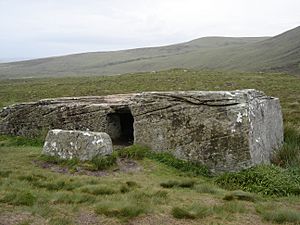
Old stories say that dwarfs were created from the earth or formed like maggots in the flesh of Ymir (a giant whose body became the earth). In early Old Norse stories, it's sometimes unclear if dwarfs live inside stones or if they are stones themselves. They are called 'masters of the rocks'.
In one story, a dwarf lures King Sveigðir into an open stone, which then closes behind them, and the king is never seen again. This dwarf was also said to be afraid of the sun, just like the dwarf Alvíss who turned to stone in sunlight.
In German legends, dwarfs usually live inside hollow mountains. But sometimes they live above ground. In sagas, they often live in single stones, which could also be their workshops. This idea of dwarfs living in stones continued into modern folklore, like with the Dwarfie Stane (Dwarf Stone) on an island in Scotland.
Some experts believe that dwarfs living in mountains, stones, and mounds might come from an older idea of them being connected to the dead, who were often buried in mounds and around large stones.
Causing Illness
In old English texts, the word 'dweorg' (dwarf) could also mean an illness, often a fever. It's thought that people in the Early Middle Ages might not have seen a big difference between the magical being and the sickness, because dwarfs were so closely linked to illness in old medical charms.
An 8th-century skull fragment found in Denmark has writing that asks for help from three beings, including Odin, against one or two harmful dwarfs. This was likely a charm to get rid of an illness. Another old lead plaque found in England says "dead is dwarf" and was probably a written charm to cure someone of a disease thought to be caused by a dwarf. An old English charm describes a sickness as a dweorg riding the sick person like a horse, similar to a harmful mare in later folklore.
The idea that diseases are caused by magical beings throwing things is common in Germanic folklore. For example, elfshot was a term for an illness believed to be caused by elves. This idea continued into modern times in places like Norway, where the word dvergskot (literally 'dwarfshot') refers to an animal disease.
Place Names
Some places are named after dwarfs:
- Dwarriden (Dwarf dale) – A valley in England.
Dwarfs in Pop Culture
Dwarfs appear in many modern stories and movies. A famous example is Walt Disney's 1937 film Snow White and the Seven Dwarfs, based on the fairy tale.
Most dwarfs in modern fantasy books are like those in J. R. R. Tolkien's The Hobbit and The Lord of the Rings. Tolkien's dwarves (his spelling) were different from elves, and most modern fantasy stories keep this difference. Dwarfs are also in books like C. S. Lewis's Narnia series, Terry Pratchett's Discworld, and the Artemis Fowl novels.
Video games also show different kinds of dwarfs. In The Elder Scrolls games, "dwarves" (called Dwemer) are an ancient race of underground elves who were good at science and engineering. They are not particularly short and are now extinct. Other games like Dragon Age and Warcraft show dwarfs as strong, bearded mountain dwellers, separate from elves. The Warhammer game has both good Dwarves and evil Chaos Dwarfs.
See also
 In Spanish: Enano (mitología) para niños
In Spanish: Enano (mitología) para niños
- Gnome
- Krasnoludek
- Smithing gods


